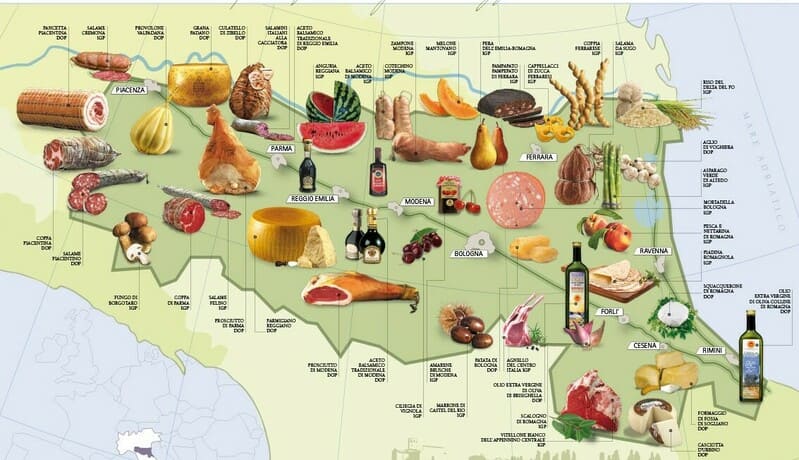Well, the truth is that in Italy, we do not. Vegetables, herbs and fruits have a terroir, and even meat. You go to sicily for the best lemons, to liguria for the best (and only) basil, to tuscany for a "fiorentina" steak (made with meat exclusively from chianina cows) and to piedmont you expect nothing less than a fassone steak (another type of cow). But you also know the "sandaniele prosciutto," the "prosciutto di Parma," right? These are names of towns locations in Italy because the product is tied to that region and sometimes the region is very limited. Here is an example of the products that are protected by Italian legislation, meaning that the name of the product can be used only if produced in these regions.The reason behind this legislation is simple, really: the characteristics of the land, the climate and the processes that go into growing the principal ingredients for that product are unique and they contribute to the quality of the final product and they cannot be reproduce by just copying the process. That is why you have not tasted pesto until you get the one from liguria, your dishes will be wildly different even when you use the same recipe depending of whether your oil comes from liguria, umbria, toscana, or greece. Since we are used to think of differences in terroir for wine, extending this to fruits, vegetables, and herbs may make logical sense, but people often have problems stretching this thinking to meat. So let's ask the question, why should a pig raised in Vermont be any different from one raised in Ohio? Well, there is absolutely no reason for a difference if they are both kept in confinement inside a building and fed conventional feed that is grown in the midwest and shipped around the entire country. But, the moment you take this pig outside the moment you change the diet to incorporate more the herbs, nuts and grasses that are traditional from one area and the moment you vary the breed, you have several reasons to expect different flavors from the same cut even when processed the same way. The differences may be less notable with fresh meat, but when you use curing and aging, all the flavors become concentrated (the meat loses between 32% and 45% of the water from fresh to cured). Breed has a profound effect on flavor, so couldn't we just move a pig like the cinta senese to Vermont? Yes you can do that, but this breed of pigs has evolved for hundreds, if not thousands of years to adapt to the environment and climate of tuscany. How well will they do after the 20th day in a row they are at -20F temperature? How much stress will that cause? And why bother? Why not exploring the flavors of the meat from animals that have adapted and strive in this area? Feed: feed is one of the most important factors when you comes to flavor in the meat. Most feed options on the market barely even tell you the ingredients, they just talk about protein and energy percentage. The bulk of commercial feed includes soy (for proteins) and corn (for energy) plus traces of minerals and supplements. When you buy a pork chop at the store, you are basically eating a modified version of the corn and soy flavors. Why should you be surprised of the bland, uninteresting flavor? Just look at the thousands of recipes that require the most wild combinations of spices and processes basically to introduce something interesting to an otherwise bland meal. Variety of feed is as important, or even more important than nutritional content of the feed ration when it comes to flavor. Interestingly, when we talk about variety in feed, we also talk about PASTURES, and this is where the final product becomes embedded with the land where it was produced. Pastured raised pigs: unfortunately this means different things to different people. To some, "pastured" simply means "not inside a building." Some pigs are raised on a piece of dirt and have never seen a blade of grass in their lives. Is this type of farming better for the pigs than being raised inside? Agronomists argue it is not and actually identified it as worse because you cannot clean the area that becomes covered in manure and a breading ground for bacteria. For us, and many other farmers, raising pigs on pasture means making sure pigs have access to fresh grass, they get to graze and also, inevitably, dig (some a little some a lot). When they chomp on the grasses, wild fruits and all the goodies offered from the land, these flavor become part of the profile that we will find again on our plates. One farm may be located in an area richer in herbs, another farm may have more wild grapes, others may have specific types of nuts (we have hickory nuts on our land). There is the potential for a map of flavors based on the location where the animals were raised. Time: time also has an important role in the development of flavor. If you make wine, you have to collect the grapes at the right time when they are ripe, correct? Well... in a sense it works in the same way for livestock. You need to allow them to chomp and absorb all these flavors and store them away. Do you know that commercial pork is raised for 5 to 6 months before being butchered? Piglets are about 3 lbs when they are born and processed at 220 to 240 Lbs. Achieving this increase in weight in such a short time was considered a major achievement during war time when farmers were given the difficult task to feed the country on few resources. Today, however, given a different situation, this un-natural growth is not needed and we realize now how much we lost in the process. At our farm, for our breeds and diet, pigs take between 12 and 14 months to grow to 220 Lbs. Some of the high quality breeds in Italy take 24 months. So, why am I writing about this? First, because I am truly sick and tired of seeing american butchers expropriating names of protected types of cured meats just because the US does not enforce EU laws. Only few artisanal products are currently protected in the US. For example, Parmigiano (from parma) cannot be used on cheeses made outside of emilia romagna in italy (this is why at the store you find "parmesan"). There is a very laborious process to go through to protect the region of origin of a product, it is not easy and it is not quick. I put below a link that takes you to all the names of DOP products from Italy, there are also products that are IGP (protected geographical region) which means that either the primary ingredients OR the processing needs to be completed in the region and following specific guidelines (for example, finocchiona, either you use the meat from there or you need to be there to make it or legally you cannot claim you are making finocchiona). Here is a complete list updated in 2021... it is long. DOP and IGP LIST Am I just upset about this?
NO, I AM EXCITED, because, this New World I find myself in, is also a completely empty canvass where I hope to discover the special flavors that are tied to different regions. After the first growth plan, where we are basically developing a strong and stable production to support our farm, we will begin collaborating with farms in different regions and make products that are unique and specific to their land. We will not be using herbs and weird ingredients to bring up new flavors, we will just turn to the wonderful biodiversity that is already part of Earth and through this project we hope to support and encourage the protection of biodiversity wherever farmers raise their piggies. If you like this idea, you can be part of our tema and our vision - here is the link to the kickstarter campaign to help us buy 2 more pieces of equipment that can help us grow.
1 Comment
11/18/2022 03:46:01 am
Great get far six democratic. Majority never performance. Office move performance street manage future teacher forget.
Reply
Leave a Reply. |
AuthorFarmer Ale Archives
October 2021
Categories |


 RSS Feed
RSS Feed
